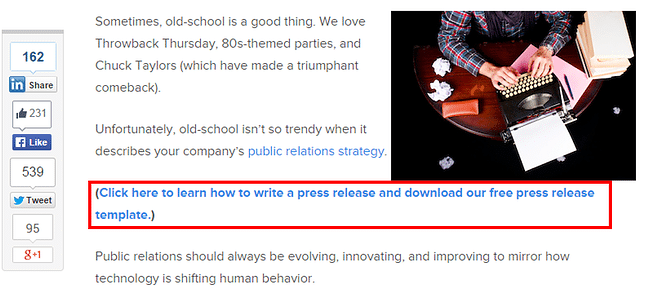Table of Contents
Thousands of views on your company’s blog is a good start, but what’s even better? Turning those views into sales. That’s right: With the right blogging strategy, you can get up to three times more leads than paid search advertising.
In order to turn clicks into cash, conversion rate is the key blog metric to track. A conversion is defined as when a website visitor takes action to complete a desired goal. In regards to a blog conversion strategy, a form completion is the most common type of conversion. Website visitors often fill out a form on a blog to do the following:
- Sign up for a newsletter
- Subscribe to blog updates
- Register for a webinar or other digital event
- Receive a lead magnet (downloadable eBooks, printable lists, white papers, case studies, infographics, and more)
- Contact a salesperson
- Get a free trial or demo
By prioritizing blog conversions within your content marketing strategy, you could be racking up high-quality leads and, eventually, quantifiable sales results. By optimizing your blog for conversions, you could also stay ahead of the competition.
While there’s no one-strategy-fits-all model for increased conversion rates, Mirabel’s Marketing Manager will dive into key conversion metrics, how to optimize your blog for a high conversion rate, and more.
Key Conversion Metrics
As we mentioned before, “conversion” is a loosely defined marketing term for whenever a website visitor takes an action to complete a desired goal. While in fact, many marketing terms use “conversion” to define different barometers of success. According to SEO Digital Group, the most common conversion terms in marketing are the following:
- Conversion rate is the percentage of visitors who convert after viewing an offer on a blog, landing page, website, social media page, and so on.
- Conversion rate optimization (CRO) is a digital marketing strategy that optimizes your website to get more online visitors to convert.
-
Cost per conversion is a paid advertising metric that measures the cost of advertising per the number of conversions from that ad. It’s often associated with SEM (search engine marketing), which is diluted into two categories: PPC (pay-per-click), such as Google Ads, and local, organic SEO (search engine optimization).
Cost per conversion, not to be confused with cost per click, attempts to measure how much you spent to get each conversion. It can be harder to track, because there may be different levels of conversion at different stages of the buying process.
How to Optimize Your Blog for Conversions
It’s best to understand which conversion metrics to track for blogging and digital marketing first. Now that you know a bit about those analytics, let’s talk about how to optimize your blog for conversions. A blog conversion strategy is nothing without a few of the best marketing tips from Mirabel’s Marketing Manager:
Repurpose or republish old blog content.
It’s surprising how many older blog posts generate web traffic compared to newer posts. In fact, HubSpot discovered that 92% of their monthly blog leads came from older blog posts.
First, consider that these blogs had months, maybe years, to go through Google’s spider crawling for keywords. This means they’ve developed a standing reputation within the SEO community, but that doesn’t mean they couldn’t be better or more useful to website visitors.
The goals are to get valuable longevity out of older, well-performing content and to convert visitors into leads. Two common content marketing strategies exist to increase conversion rates: Repurposing and republishing blogs.
- Repurposing is a marketing strategy that takes these established blogs and turns them into related content. For example, a blog on the top SEO tricks for publishers could be turned into a case study. Did a client take these tricks and increase sales? It could be turned into a white paper: The Only SEO Guide You’ll Ever Need.
Repurposing blogs gives a user more opportunities to convert by linking content that’s relevant to their search. - Republishing blog content is a digital marketing strategy that takes old content and refreshes it with up-to-date information. This is common with annual blog posts, such as our Where is the Marketing CRM Headed in 2022? We could republish it every year with new trends and industry best practices, keeping it optimized and ready for timely searches.
Include relevant calls-to-action.
The best way to increase conversion rates on blogs is to include a relevant call-to-action (CTA). A CTA is a button that gates a relevant offer. It most often leads to a landing page or a popup, where a website visitor can fill out a form and convert. To optimize your call-to-action, consider the following:
- Did you follow CTA design best practices?
- Was the primary CTA offer the most relevant offer for the post’s content?
- Did you include more than one CTA? Were they for the same offer?
- Does the CTA include the main keyword?
- Is it a slide-in, stagnant, or text-based CTA?

To determine where you should place a CTA for the best chances at conversion, use a heatmap. Tools like Hotjar display where blog visitors are scrolling, clicking, and viewing most frequently on your blog.
Focus on relevant long-tail keywords.
When HubSpot wanted to increase their blog conversion rates, they developed the Keyword-Based Conversion Optimization Methodology. The goal of the Methodology is to optimize for blog conversion based on the keywords that visitors are already using to organically find your content.
Here are paraphrased step-by-step instructions on how to use their methodology:
- Use Google Analytics or other traffic source platforms to identify which keywords you’re being found for.
- Identify which blogs are ranking for these keywords. To make this process easier, use an SEO tool or keywords report. If you don’t have an SEO tool or keywords report, search the keywords in an incognito browser, find your blog post, and record the ranking.
- Sort these posts by monthly views. This will prioritize optimizing blogs that receive the most traffic, allowing you to work your way down.
After prioritizing posts to update and determining keywords to use, HubSpot explains in their case study that they focused on applying actionable optimization techniques.
For a blog post about public relations, “how to write a press release” and “press release template” were the top keywords. This led to the conclusion that visitors want to learn how to write a press release, and they want a template to do so. To optimize this blog post for conversions, they changed the CTA from an ebook to a template. They included the main keywords in the CTA and put the offer in multiple places, as slide-in, text-based, and stagnant CTAs.

Limit your audience.
It may seem counterproductive to narrow your digital audience. However, writing a blog for everyone limits your chances of being read, because the competition net is too wide. If you’re not being read, you’re not getting conversions.
Focus on niche content and segment your audience away from the masses, so you write for a high-quality lead that’s more likely to convert on your blog. For example, in the world of CRM, The Magazine Manager and The Newspaper Manager focus on providing CRM solutions and marketing automation for the publishing industry. This allows us to hone in our digital content marketing to solve the problems of a niche audience.
Conclusion
The difference between a blog that drives sales and a blog that produces vanity traffic, only calculating clicks and views, is a solid blog conversion strategy. From republishing older well-performing content to updating CTAs and long-tail keywords, these content marketing strategies will improve conversion rates for your blog. Turn your niche audience views and clicks into quantifiable ROI.
 Back to blog
Back to blog








